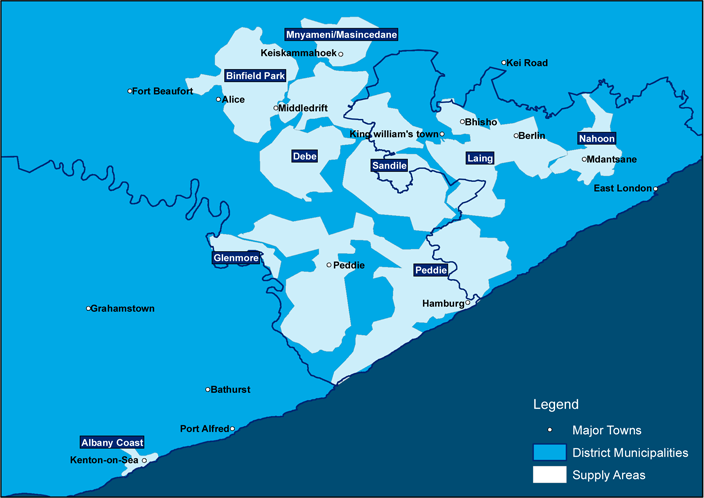WATER QUALITY REPORTS
Amatola Water Scientific Services was established to be an arm which is aimed to support the Operation Division. Its primary function is water quality compliance monitoring, which include sampling and water testing.
Scientific Services Laboratory is accredited by the South African National Accredited System (SANAS) in line with ISO 17025 lab accreditation system, which gives formal recognition to laboratories and other testing facilities, ensuring they are competent to carry out specific tasks. It has received this recognition in 2015, after being fully assessed for both management and technical competence. The lab consists of three sections which include: Microbiology lab (for microbiological testing), Inorganic lab (for inorganic analysis) and Organic lab (for organic analysis).
The laboratory is staffed by highly qualified scientists and lab technicians with experience in a wide range of chemical, physical and microbiological analysis. For the lab to fulfil its role, it has a sampling plan which is linked to specific sampling points. Frequent samples are taken throughout Amatola Water areas of supply which includes networks, water works and catchments areas (Dams).
Water quality testing is an important tool to ensure safe drinking water. All water from natural sources contains dissolved substances. These substances are often called contaminants and can be as a result of natural processes or human activities. At low concentrations, many of the substances in water do not cause known harmful effects and may be beneficial.
The only way to know if the quality of the water is suitable for its intended purpose is to test the water by using analytical testing methods in order to determine what substances are present and their concentration levels. Water quality testing helps to determine the chemical, physical and biological characteristics of water.
In South Africa, the quality of the domestic water supply that is considered safe for human consumption is assured by monitoring for compliance with the South African National Standards (SANS 241).
The drinking water quality standard (SANS 241:2015) requires both chemical and microbiological components to meet the minimum compliance standard of 95% for a given population.
Drinking water quality below 95% is considered unacceptable and the Department of Water and Sanitation may impose penalties for non-compliance.
Microbiological Compliance*
Microbial water quality is the state of the water with respect to the absence (good water quality) or presence (poor water quality) of micro-organisms. Microbial water quality is usually indicated by reporting the count (number) of indicator organisms present in a given volume of water. SANS 241 requires >95% compliance for a population of 100 000 or more.
Chemical Compliance*
Chemical water quality refers to the nature and concentration of dissolved substances such as salts, metals and organic chemicals. All determinants with a possible threat to health are listed. SANS 241 requires a minimum >95% compliance for a population of 100 000 or more.
Determinants
- Acute Health microbiological Deteminands: These are the organisms in drinking-water which could pose a risk to health if such water is consumed, e.g., E.coli which cause diarrhoea, and need urgent care.
- Acute Health Chemical: The presence of chemical contaminants in drinking water which could pose health risk, e.g., Nitrate with potential to block the flow of blood.
- Chronic Health Chemical: These are chemical contaminants when consumed over long period can cause irreversible diseases such as cancer, Total triholomethanes or lead
- Operational: They are important because they affects both the acceptability of water to consumers, and the selection and efficiency of treatment processes, particularly the efficiency of disinfection with chlorine since it exerts a chlorine demand and protects microorganisms and may also stimulate the growth of bacteria.
- Aesthetic: Aesthetic parameters are those detectable by the senses, namely turbidity, colour, taste, and odour, the most commonly known chemicals associated with taste are inorganic/organic salts such as sodium/chloride.
Drinking Water quality compliance
% Compliance SANS 241:2015 new reporting of Supply Systems Jan 2017 to Mar 2017 Q3
| Category | Laing | Sandile | Nahoon | Albany Coast | Debe | Peddie | Glenmore | Binfield | Masincedane | Mnyameni |
|---|---|---|---|---|---|---|---|---|---|---|
| Acute Health Microbiologic Compliance | ||||||||||
| Acute Chemical Compliance | ||||||||||
| Chronic Chemical Compliance | ||||||||||
| Operational Compliance | ||||||||||
| Aesthetic Compliance | ||||||||||
| Average | ||||||||||
| Population | 172,600 | 121,500 | 185,000 | 16,000 | 17,200 | 81,500 | 5,000 | 43,800 | 13,500 | 3,700 |
Excellent
Good
Unacceptable
| Population served | No. of monthly samples |
|---|---|
| <5000 | 2 |
| 5000-100 000 | 1 per 5 000 head population + additional sample |
| 100 000 – 500 000 | 1 per 10 000 head of population + 11 additional samples |
| ≥ 500 000 | 1 per 20 000 head population + 36 additional samples |
| asdf | asdfasd |
Minimum sample numbers for drinking water in the distribution system.
View sampling sites that are currently being monitored.
Amatola Water Supply Systems


